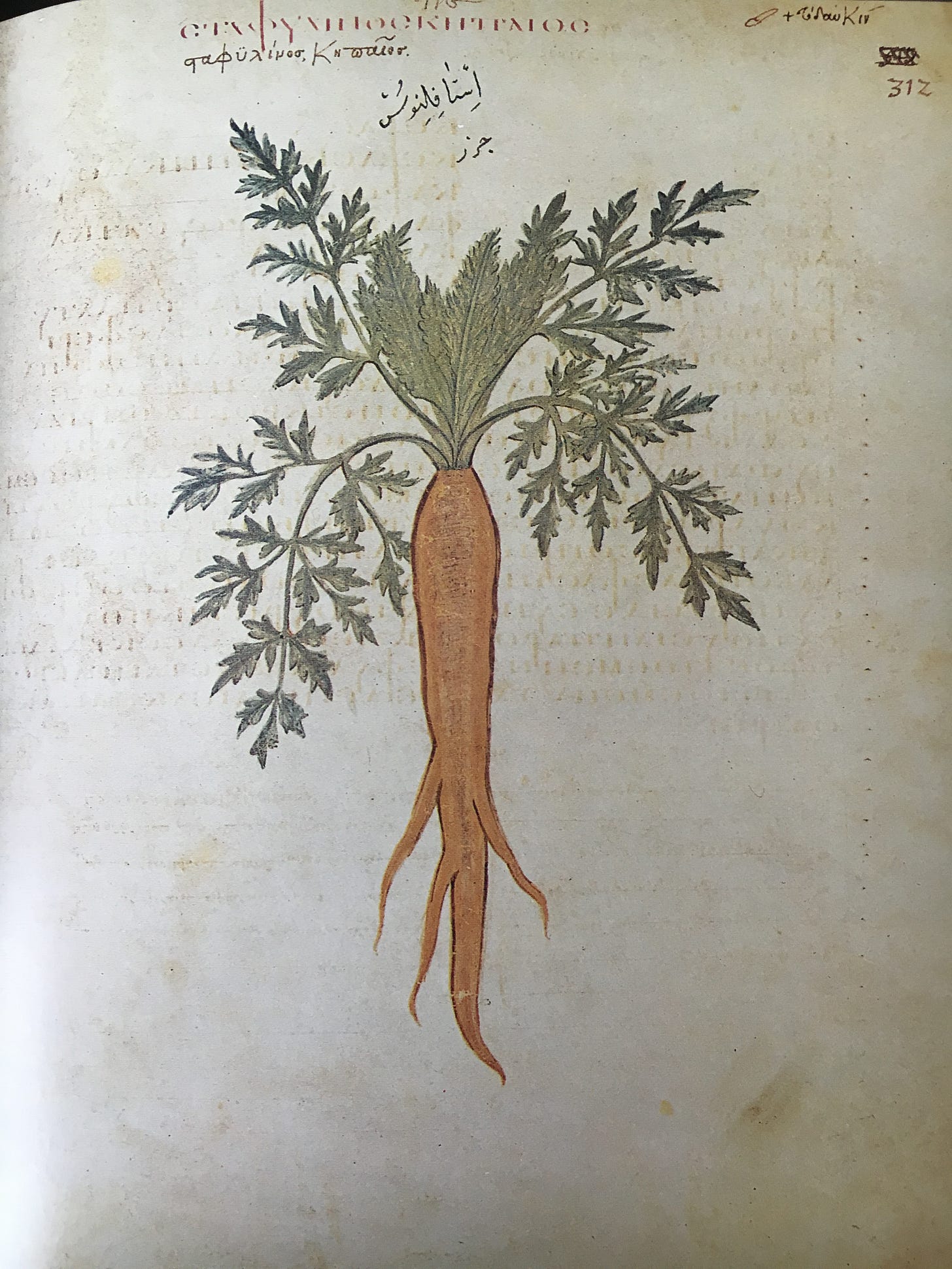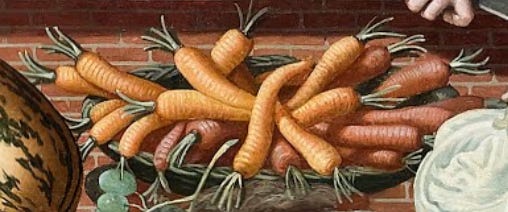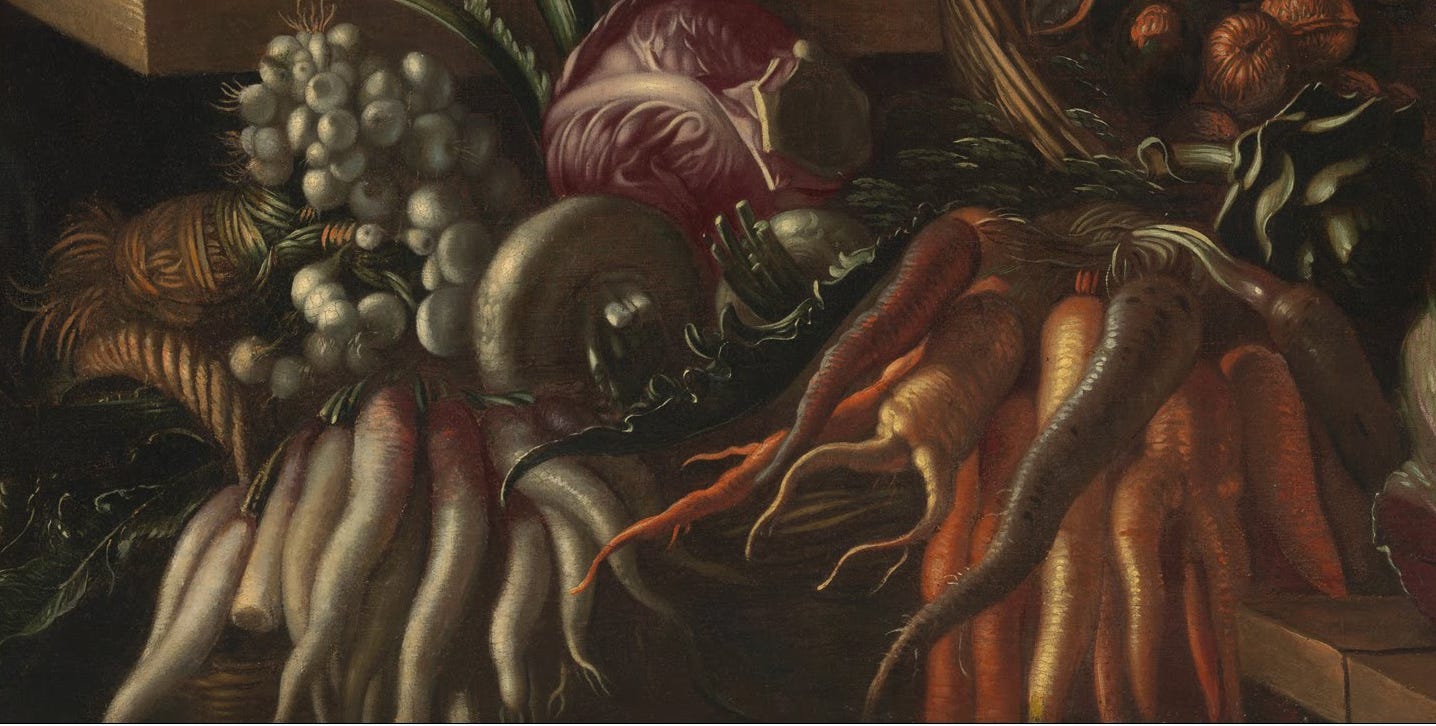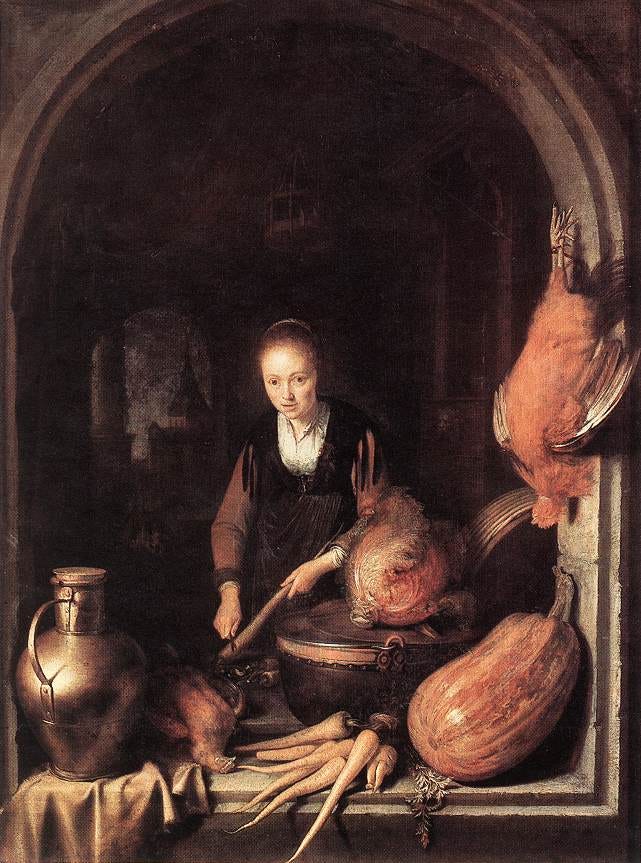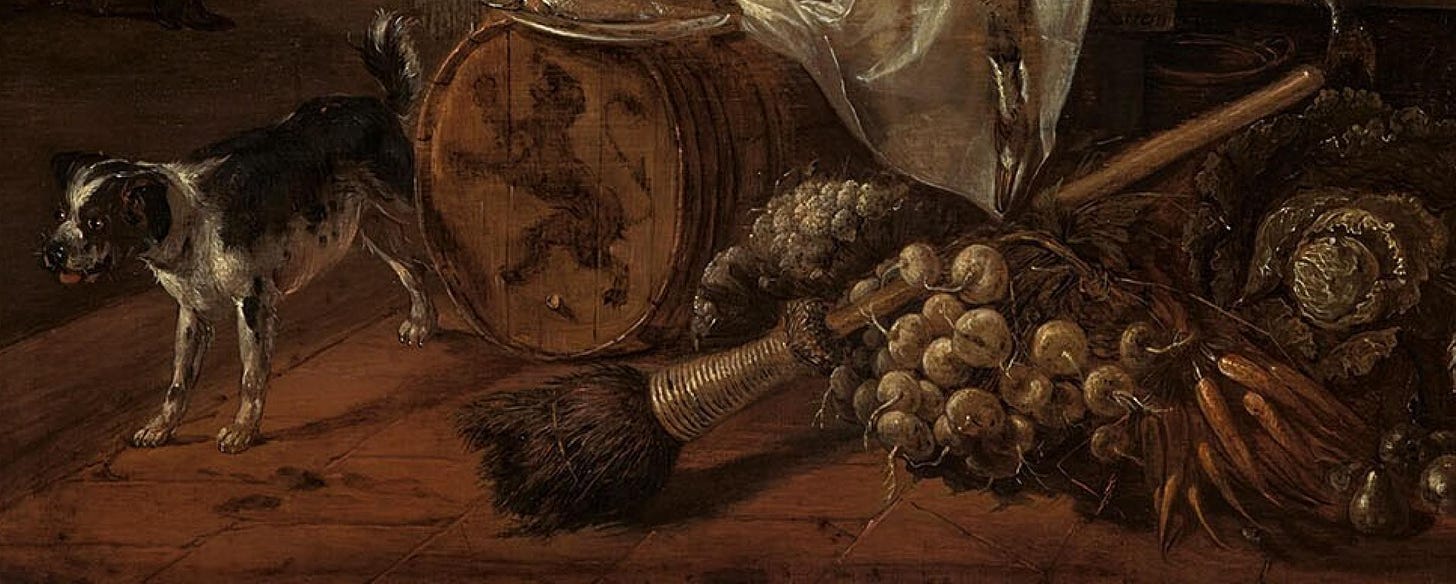Yes, Carrots Really Are Orange Because of Orangists
Armed with genomics, Bayesian statistics, and art history, I take on the most trivial possible topic.
I really wasn’t expecting to do a followup to Why Carrots And Princes Are Orange. Not on Substack, anyway—for some reason I eventually tell this story on every platform I’m on. But when I crossposted a shorter version of the story to Reddit, I got some helpful and interesting comments, as well as a surprising amount of pushback to the second-to-last leg of the journey, where orange carrots come to dominate the other varieties because of the House of Orange. So I did more research, and ended up strengthening my claim. Yes, not only did Orangist farmers cause orange carrots to take over, they invented them. The orange carrots that occasionally pop up in older sources are a separate cultivar that the Dutch didn’t have access to.
Before I get into the argument (which you’re welcome to skip if you’ve subscribed to this newsletter for entertaining or useful stories), let’s highlight some of the other comments.
EirikrUtlendi traces the actual moment the first “n” got dropped in the name of the fruit back to Old Italian, which Old French then copied:
French apparently never had any word narange: the French word orange was borrowed in the Old French stage of the language as pomme d'orenge (apparently also attested as Old French pume orenge), in turn a calque (translation of individual parts) of Old Italian melarancia, itself a compound of mela ("apple; apple-like fruit") + arancia ("orange [tree]"). The rebracketing seems to have happened in Old Italian, where the term arancia is traced back to Persian nârang, probably via Arabic nāranj (which better explains the final consonant in the Italian). Also attested as Milanese naranz.
Tutush speculates on what the town of Orange would have been named, if the word “orange” had kept its initial n in French. Occitan, or Provençal, another language still commonly spoken in the south of France, gives the name of the town as Aurenja or Aurenjo. So if we look at other French/Occitan town name pairs, we can apply the same mapping and get the likely French equivalent. Mainly French just seems to drop the trailing vowel, if there is one (e.g. Carcassona becomes Carcassonne) and occasionally shift consonants a little. Tutush suggests Aurenne or Aurençon. I also notice a couple of cases where a trailing “ha” is converted to “gne:” Anha to Aigne and (in Spain) Catalonha to Catalogne. So I think Aurigne, a real-life French surname, is also a candidate. The French name for the island of Alderney is “Aurigny”, so the initial Aur probably survives unchanged in all of these scenarios. Aur means “gold” in Occitan, as in many other Romance languages, so the House of Aur-something would more likely have been associated with gold than orange.
Finally, DesperateBartender objects to my use of the perfectly cromulent comparative “oranger.” The correct word, they note, is “morange.” This sort of comment is why the phrase “angry upvote” was invented.
Thanks to all of you! Now, on to the argument.
A Brief History of the Carrot
(I feel like it’s more my style to name this section something like “the roots of the carrot” but I’ve had to wade through too many of those punny titles in researching this.)
Carrots have been native to Europe and Southwestern Asia for at least four thousand years. For much of that time, probably, people were harvesting wild carrots but not eating the roots—they were using the leaves as garnishes, like people today use its relative parsley, and eating the seeds. The earliest solid account of people eating the roots comes from the Roman Empire, where they thought it was an aphrodisiac. But legends place carrot (root) consumption much earlier—supposedly, some versions of the legend of the Trojan Horse, which takes place a thousand years before the Empire, have the soldiers eating a lot of carrots before getting into the wooden horse so that they’d be constipated during their long, bathroomless wait to be brought within the walls.
Similarly, the earliest we can confidently place the start of people farming carrots is the tenth century, when the first Arabic-language book on agriculture was written. But that book claims to be a translation of a 20,000-year-old Mesopotamian text, and while that’s almost certainly not true, there probably was an original written in Syrian Aramaic at least a few centuries earlier. Eating the roots of carrot plants would probably have required breeding them for larger roots, so some level of carrot engineering must’ve been going on by at least Roman times.
These more modern-shaped carrots were then introduced to Europe and China by travelers from Afghanistan and/or Iraq. By the 14th century, they were being grown “around most towns” in the Netherlands.
Now, what colors were they during this long history of domestication? As this paper notes, this isn’t quite as easy to answer as it might seem because people in the past often used color words differently. In particular, references to “red” carrots are probably actually about what we would call “purple.”
Almost all sources from these periods describe varieties of at least two different colors, probably-purple and yellow. Some also discuss “white” carrots, which do exist, but those might in some cases have been pale yellow carrots or white parsnips. Many sources, including that tenth-century one, say that the probably-purple carrots are tastier.
However! The Juliana Anicia Codex, a 512 Byzantine text, has something most of these other sources don’t: pictures. Here’s one.
This puts something that looks a whole lot like the modern carrot in the 6th century! That’s the main reason scholars like the ones behind the World Carrot Museum decided that the Dutch couldn’t possibly have invented it. Not only was the Netherlands not growing carrots back then, a lot of the Netherlands didn’t even physically exist! I don’t really blame them for jumping to conclusions, here. I think they’re wrong, but that picture’s a really good piece of evidence, and the genetic study I’m relying on to rebut them was only released less than a year ago, in 2023.
The Population Genomics of the Carrot
That study, which you can read on nature.com, sequenced the genomes of 630 different carrots from around the world, then ran the results through TreeMix, a nifty open-source program that infers a genealogy tree from genetic similarities. This allowed them to separate their samples into five broad populations, which they then did further genetic comparisons of to map genes to characteristics (genotypes to phenotypes).
They concluded that there are three different genes that can make a carrot morange (sorry). Two were previously known, Or and Y2, and their study surfaced a third, REC. Carrots with none, or only one, of the three are almost never orange. Carrots with two are orange about 25% of the time, usually a pale orange. Carrots with all three are orange 96% of the time, and nearly all the dark orange color Bugs Bunny likes. This model predicts something that’s at least compatible with our other historical evidence—orange carrots would’ve been rare, but would still pop up every so often.
The scientists then checked their results against where the carrots were found, as well as various speculative accounts of the history of the carrot. The key finding, colorwise, is that if you look at the one branch of the tree from which modern orange carrots descend, all the carrots at the “base” of that branch are yellow. The genes were there, but since you need multiple different recessive genes for orange carrots, they weren’t mattering.
The key finding, history-wise, was that one of the other papers I’ve been referencing, O. Banga’s The Origin and Distribution of the Western Cultivated Carrot (1961), is the most compatible theory with their genomic data. In summary—yellow carrots were a common mutation of purple carrots. When carrots were introduced to Europe, founder effects made yellow the more common color in some areas, including the Netherlands. Purple and white carrots were still around, but not in the higher proportions they were in the east.
Then, at some time that’s still difficult to pinpoint, orange carrots started to be more of a thing there. Happily, this was during the Dutch Renaissance, so people were creating realistic paintings of vegetables! So Banga realized that we can actually see a time-lapse of this evolution. Here are some carrots from a 1569 painting that is trying as hard as it can to be NSFW using only vegetables and suggestive poses:
I have a real problem here which is that my brain insists on color-correcting all these painted carrots to orange. It’s just the light, it insists. But no, people seem pretty confident that the lighter ones are yellow and the darker ones are purple.
Here are some carrots from around 1618:
Now those are some orange carrots! And they’re a plurality! That’s three purples, four yellows (note how similar those look to the carrots above), and five oranges. (The white roots on the left probably aren’t carrots).
But that wasn’t universal. Around the same time, we get paintings like this:
I’m showing the whole painting rather than a detail because again my mind insists on interpreting those carrots as orange, just washed out by light. But helpfully, the painting is full of actually orange things to compare them against, making it clear that these are a very pale yellow with the tiniest hint of orange.
A few decades later, it gets more common for carrots to be uniformly orange. Here’s a detail from a painting from between 1636 and 1684:
We can see some dark orange carrots in the bottom right. I’ve included the dog because the black-and-white pattern lets you calibrate—nah, it’s because I like dogs. Also, notice that drawing on the barrel the dog may or may not be peeing on? That’s the rearing lion from the Nassau part of the House of Orange-Nassau coat of arms. Orange iconography was spreading along with the orange carrot.
We can see the later association between the House of Orange and carrots by stories like these (I feel like this is probably exaggerated out of royalist solidarity, but it’s too fun not to share):
During the triumph of the anti-stadtholder faction popular feeling manifested itself in some odd ways. The body of the people have always been gratefully attached to the House of Orange, as it became them to be. To prevent all manifestation of that feeling the ruling faction forbade the market women to expose carrots for sale. They were enjoined on pain of fine to keep them covered under other greens. Carrotty cats were hunted down to be extirpated and marigolds rooted up by men sent for the purpose. Of course such measures provoked the spirit which they were desired to suppress. The fishwomen cried orange salmon through the streets, marigold seeds were scattered everywhere, and particularly in the gardens of the factious, and pigeons were dyed orange colour and let fly. The two latter tricks excited some superstitious feeling.
But Which Caused Which?
None of the farmers who engineered the orange carrot wrote down why they did it. There’s a tendency, skewered by Scott Alexander here, to treat “no evidence that it’s true” as equivalent to “it’s been conclusively debunked.” This is only the case when you’ve collected data that would have contained evidence if the hypothesis were true. If you do a bunch of large-scale controlled trials and find no evidence that a drug works, the drug probably doesn’t work. If you haven’t done those trials yet, the fact that you haven’t done them isn’t evidence for or against.
Would there be written explanations of why they were selecting for orange carrots, if the answer were “to support the House of Orange?” Almost certainly no! There were not a lot of Dutch texts on agriculture, period, back then, especially not those written by the people involved. The Dutch were unusually literate for their time, but still, the estimated number of people there who could sign their name in 1500 is around 10%, and I think most of those people would have lived in cities. Also, supporting the House of Orange was a revolutionary activity, at first. Rebels in the Eighty Years War would hoist an orange flag over cities they controlled. The eighty years in question were roughly between that no-orange-carrot painting at the beginning and the all-orange-carrot painting at the end. During the time the shift was happening, writing about your support was a significantly more dangerous way of expressing it than, say, adding a touch of orange to things.
So the lack of written explanation doesn’t really give much evidence either way. But it gets treated in “debunking articles” as though it’s a solid disproof, rather than a reason we have to rely on oral tradition and circumstantial evidence. An absurd number of things are like this—people rarely remember to be skeptical of skepticism.
The affirmative case for the House of Orange hypothesis comes in two parts. First, there’s the fact that oral tradition, among the descendants of the people who created the orange carrot, says that it was meant as an Orangist statement. The straightforward interpretation of this is that it’s true. The most common alternative explanation is that it’s a myth that gained popularity because tourists liked it. But of course there are a lot of myths tourists would’ve liked, so the universality of this account is still pretty good evidence for the hypothesis.
Second, there’s the highly suspicious timing. Carrots had been domesticated for at least eight hundred years. They’d been in Europe for over two hundred years. In all that time, orange remained a rarity. Then, at exactly the place and time where the color orange became a political statement, the orange carrot was created and became dominant over the other colors. Considering how widespread carrots were, this is very strong evidence in a Bayesian sense. Any account of why carrots became orange that doesn’t specifically predict it happening in Holland during the Eighty Years War gets a large penalty vs. one that does.
But coincidences do happen. So let’s take a look at alternate explanations.
Orange carrots were hardier. This is somewhat true in the present, but only because we’ve bred carrots for both orangeness and hardiness, so we’ve created a correlation. The genetic study didn’t find a reason for the two properties to be inherently coupled. And to me, this is a priori much less likely because it would predict orange winning much earlier, due to natural selection, in the climates that suited it. Wild carrots existed in Europe for thousands of years without the orange alleles getting selected for. We know the alleles existed as of 512 at the latest, but they never achieved fixation, so they can’t have improved fitness.
Orange carrots were tastier. Also true in the present for the same reason as hardiness. It’s hard to tell whether that would’ve been true in the early stages of artificial selection. I think it easily could’ve been, but we don’t know. But what we do have ample evidence of, from multiple earlier carrot-growing cultures, is that the purple carrots tasted better than the yellow ones. We know the Dutch had both in 1569. So if they were trying to breed tastier ones, why start with the yellow ones? For the orange color to be a byproduct of taste, we still need the yellow to have had some other advantage that made it worth preferring as a starting point. It’s plausible, but I haven’t seen the case made.
Orange was an arbitrary marker to make it easier to tell domesticated carrots from wild ones. This hypothesis is suggested in the paper about the genetic study, and I’ve seen it a few other places too. It seems plausible to me! But I think the lack of evidence hurts this hypothesis more than the House of Orange one. If you’re using something as an arbitrary signifier of quality, you’d want to communicate that. That and the Bayesian argument (if it could’ve been any color, why orange?) work against this theory, at least by comparison.
And…that’s it, as far as I know, for hypotheses. I could make some more up, but I’d be pulling them out of thin air.
So here’s the state we’re in. The Dutch claim, for a long time, that they invented orange carrots in the 16th century to honor the House of Orange. Then, people discover evidence of orange carrots already existing in other places, so they stop believing the “invented” part, and if you’re willing to doubt that, why not doubt the rest too? But now, we have a genetic study that backs up the original Dutch claim! Carrots could be orange before then, but they did invent the ancestor of all modern orange carrots in the 16th century. We don’t have any strong alternative explanations to the traditional Dutch one, and it fits all available evidence. That’s the sort of story we generally accept as probably true.
In Conclusion
I’m pretty sure I spent a day and half on this solely because my pride was stung by having people say I was wrong. But after the fact, let me try to retroactively make it part of a larger point. It’s so easy to score points by treating absence of impossible evidence as evidence of absence. “Were you there?” say creationists, smugly. “It’s unscientific to say that all humanity can be wiped out by a rogue AI until it’s happened a statistically significant number of times,” say others. Genomic research has confirmed plenty of traditional beliefs dismissed by colonizers because of a lack of written evidence—see the story of Beta Israel in Ethiopia, for example. If you want to feel superior to someone, just find the belief they have with the least direct evidence, and flatly announce that it’s false. Try not to think about all the things you’re confident in but could never conclusively prove.
So, the call to action: remember to be skeptical of overconfidence, including when it’s overconfident skepticism. I stated my conclusion as fact in this post’s title, to counterbalance all the articles where the headline does the opposite. But, like those articles generally do, I’ve moderated that confidence in the body of the piece. It seems quite likely to me. But if somebody finds evidence for an alternate theory, don’t rebut them by linking to this article and saying “this proves you’re wrong.” Knowledge is all likelihood ratios and uncertainty. Choices are discrete, but the beliefs they’re based on live on a continuous spectrum. A healthy worldview allows you to move down and up on that spectrum in response to evidence and arguments, like a carrot evolving to be less or morange.





